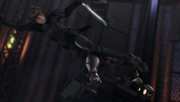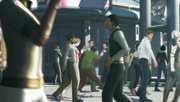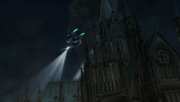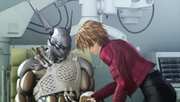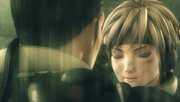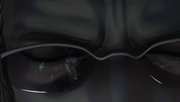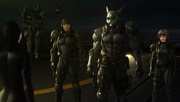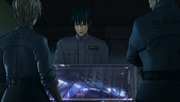Changes made to Review for Appleseed: Ex Machina
Revision 1
Created on Tuesday, 4th April 2017, 16:31
Change Submitted by Jitendar Canth
List of Changes:
-
Change #1 -
<newline>Review[heading]Introduction[/heading] <newline>Masamune Shirow may be one of the most exciting talents in manga, after all he did give the world Ghost in the Shell, but it took a good while for his Appleseed property to get a worthy treatment in anime form. The first OVA outing back in the eighties wasnt immediately impressive, while Manga Videos treatment of it entailed a whole lot of added profanity that removed it from the grasp of its target audience. That DVD still makes me shudder. It wasnt until 2004 that the technology became available and affordable enough for anime creators to do the story and the world of Appleseed justice. <newline> <newline>Even then it took creators with a singular and contrary vision to make it happen. After all, anime is traditionally a 2D medium, and even when 3D elements intrude, the characters remain flat. It was the advent of companies like Pixar and Dreamworks that made Fumihiko Sori realise that anime could be delivered with such 3D vision as well, and with the toon-shading technology taken from computer and console games, the unique look of anime neednt be lost in the process. 2004s Appleseed was the first major application of these techniques to anime, and it was certainly a revolution, a feature length, 3D anime. Its not a technology that has been rapidly taken up though, and indeed Fumihiko Sori remains its most prolific proponent. He produced Appleseed, and went on to direct Vexille, and most recently the OVA TO. Later this year Manga Entertainment will release another 3D CG animation from Japan, Tekken Blood Vengeance, and slowly and surely it is beginning to find its place alongside traditional anime. <newline> <newline>I was very impressed by Appleseed (2004) when it was released by Optimum, a smart action movie with an engaging story, enough so that youd expect me to have pounced on the sequel when it was released in 2008. Except that this time, Warner Home Video had the licence, and they were marketing to a general audience, not just to anime fans. The DVD came without Japanese audio. However, the clout of Warners meant that it would be released in the UK on Blu-ray, a format which smaller specialist anime companies still struggle with today. The Blu-ray would have Japanese audio, although it still wouldnt be without its problems. When I finally caught up to the high definition bandwagon last year, one of the first titles that I bought was Appleseed: Ex Machina and it has languished in my Blu-ray pile ever since. It was a re-watch of the original Appleseed movie that finally spurred me to watch the sequel. I really shouldnt have delayed, as while Shinji Aramaki returns to the directors seat, this time doing the production honours is none other than John Woo, and it certainly shows! <newline> <newline>Following the final war in the middle of the twenty-second century, the survivors of humanity have picked themselves up and started to rebuild, this time with a view to avoiding the problems that have so afflicted humanity in the past. Thats exemplified in the future utopia of Olympus, where humans and cyborg survivors of the last war live side by side with genetically engineered and emotionally controlled bioroids. The bioroids are supposed to be a moderating influence on humanity, and serve as rulers and administrators, leaving people to live quiet and peaceful lives. It doesnt always work out that way, and up to now, ESWAT has been charged with keeping the peace, and stopping those who would threaten Olympus. Prominent among ESWATs members are former soldier Deunan Knute, and her cyborg lover Briareos, although their unique approach to their work tends to cause panic attacks for their superiors. <newline> <newline>That approach finally threatens their lives when a hostage situation at a church spirals out of control, and Briareos is injured in an explosion. While he recovers in hospital, Deunan is issued a new partner, ordered to engage in a new experiment. An experimental bioroid has been created for combat and law enforcement, and Tereus is the first recruit. The problem for Deunan is that to create Tereus, they used sample cells from the most promising donor, in this case Briareos. Now Deunan has to work with a being that wears the face of the man she loves, before he became half machine. And its not just in looks that Tereus resembles Briareos. There are more serious matters afoot though, as Olympus is moving ahead in its plans to reunite the world under one security network, in essence extending its utopian vision. To that end, a global summit is due to be held in the city. But Olympus faces a terrorist threat unlike any before, of which that church incident was only the beginning. It seems that cyborgs are being co-opted against their will to attack the government, falling subject to an unseen puppet master, and it turns out that not even Briareos is immune. <newline> <newline>[heading]Picture[/heading] <newline>Appleseed: Ex Machina gets a fairly impressive 1080p widescreen 1.85:1 transfer on this Blu-ray disc. Although the movie was made the same year as Vexille, it looks a generation more advanced than that movie, with a much richer and complex world design, stronger character designs, and much more striking animation. Of course that would place it 2 generations ahead of the original Appleseed film, and comparing the two really is a worthless exercise. The action sequences in this film are stunning, the character animation, motion captured from live actors, is fluid and realistic, and you very quickly forget the novelty of 3D CG and just accept it as an animated movie. The transfer on the disc is superb at first glance, but its only if you get really nit-picky that you notice the slight digital banding on colour gradients. More noticeable is some shimmer and moiré on fine detail, which if visible on my comparatively small screen, could prove problematic on screen sizes 50 and above. <newline> <newline>[heading]Sound[/heading] <newline>The audio is where Appleseed: Ex Machina falls flat, delivering an SD experience with the HD visuals. You get DD 5.1 audio in English and Japanese, as well as DD 2.0 Stereo Cantonese, French, German, and Dutch. Subtitles included are English, HOH English, French, German, HOH German, Dutch, Complex Chinese and Korean. While the surround audio is encoded at 640 kbps, and you certainly get the music and effects thrown around the soundstage with abandon, there are moments that action sequences feel subdued, and the dialogue understated. A lossless audio track is certainly missed. <newline> <newline>I do prefer my anime in the original language, but I was also hoping for a little continuity of voice acting as well. Unfortunately, other than Ai Kobayashi returning as Deunan Knute, the other characters were recast, although they all slot into the roles with ease. Youll also find with the motion capture techniques used to animate the characters, the Japanese dialogue syncs up perfectly with the characters lip movements. This isnt so for the other languages. If you were looking for continuity in the English dub, youll be disappointed again. The original Appleseed movie had two releases. The first DVD release was by Geneon, and that was released in the UK by Optimum. Later, it was re-released by ADV Films in the US, this time on Blu-ray as well, and they recorded a new dub. Its that dub cast which was retained by Warners for Ex Machina, so UK viewers wont have that continuity. <newline> <newline>The problem with the Warners release is that the English subtitles, even though they say they are for the original language, are closer to dubtitles, indeed appear to be taken from an early dub script, matching some of the English dialogue perfectly. If you know just enough Japanese to get you into trouble if you try speaking it, youll probably notice that the dialogue and the subtitles dont always match. Still, between the choice of original language with pseudo dubtitles, and no Japanese audio at all, Ill take this. <newline> <newline>[heading]Extras[/heading] <newline>Theres no main menu screen! The film autoplays, with its audio defaulting to English and youll have to use the pop-up menu to change it, then navigate back to start the movie over again. Whose daft idea is this innovation? <newline> <newline>Actually there is a main menu screen, but it only lists the extra features. <newline> <newline>Top of the list is the audio commentary, with Jerry Beck of Cartoon Brew hosting the films producer Joseph Chou. Its a gappy but really quite informative track, offering some insight into the films production, and how John Woo and Shinji Aramaki came to work together on the film. <newline> <newline>Then there are four featurettes, presented in 1080i resolution. All of them follow a similar format of inviting input from outside observers, critics, and fans, while input from the actual movies creators is limited to a few soundbites. <newline> <newline>Team-up: John Woo and Shinji Aramaki lasts 16½ minutes and looks at the collaboration of the two filmmakers and how it resulted in the look of the final film. <newline> <newline>Revolution: Animating Ex Machina lasts 19 minutes and takes us behind the making of the film, how they built on the first Appleseed to take the story and the imagery to a whole new level. Theres some look at the motion capture, and a brief visit to ADV where the English dub was recorded. <newline> <newline>The Appleseed Chronicles lasts 20 minutes and looks at the Appleseed phenomenon from its inception back in the early eighties. The very private Masamune Shirow contributes in the form of some of his written comments over the years about the series, and most of this featurette looks at the history of the manga. There is a bit on the films, but the OVA outing only gets one passing sentence of consideration. <newline> <newline>Finally East Meets West is a light-hearted 19-minute look at how anime and manga culture has grown through cross-cultural pollination, although mostly from a US outlook. But this was filmed back in 2008, before the economic downturn, and when the anime industry looked a whole lot more rosy in the West. <newline> <newline>[heading]Conclusion[/heading] <newline>The first Appleseed was an interesting film, more a test bed for a new animation technology than a full-scale feature film. It nevertheless told an engaging story, with interesting characters, and a very appealing world design. But I have to admit that much as I enjoyed Appleseed (2004), there was always a little voice in the back of my head picking nits at the visuals, at the limits of the animation, at the flat, plastic looking character designs. There was something unearthly about it that kept me from engaging fully with the story. Appleseed: Ex Machina is a full on summer blockbuster! And it has none of those issues that the first feature had. The CGI technology used to realise its world and its characters has been perfected, there is a realism and weight to the animation that the first film lacked, and it takes less than a minute to fully engage with what is happening on screen. Appleseed: Ex Machina throws down the gauntlet, challenging Hollywood at its own game. Its taken the tools developed both in Japan, and by companies like Pixar and Dreamworks, and used them to create a proper action movie, aimed at an adult audience. Now thats a gauntlet that no animation house in the US has dared to pick up. <newline> <newline>Also, despite a producer credit, Appleseed: Ex Machina actually feels like a John Woo feature. All of those little touches, the brilliantly choreographed action, the bullet time, the doves, the guy jumping sideways while shooting a gun, its all there. But this sort of homage was apparent in the first Appleseed as well. This time its the emotional touches that John Woo brings to the film as producer that really makes it stand out. This time the film really builds on the relationship between Deunan and Briareos, initially establishing its strength by showing how closely the two work together in the church siege. Its rendered unstable when Tereus is introduced, a bioroid with Briareos original face, essentially a clone. Then their unity is threatened when it becomes clear that Briareos cyborg half is a danger to them all, vulnerable to outside control. The emotional tension between these three characters is the heart of the film, and makes it compelling viewing. Deunans affections begin to drift between the cyborg she loves, and the man who looks like the man she first fell in love with. For Briareos, he has to come to terms with his machine half and his humanity, a dilemma made all the more tangible by Tereus existence, while for Tereus, he has to understand his own feelings as a created being, faced with a woman that hes genetically inclined to be attracted to, as well as the reality of his own progenitor Briareos potentially threatening their lives. <newline> <newline>The emotional dynamic drives the film, but doesnt overwhelm the story, a cyberpunk thriller thats paced to perfection, full of action beats and the exposition required to give it meaning. In a way it echoes the story of the first film, with utopia threatened by someone who has a plan for a different vision of how society should exist, and intent on bringing it about by violent and criminal means. That means terrorism, mind control, and technological infiltration. Its a race against time to investigate and uncover the threat; the stakes get progressively higher as the story unfolds, leading to the requisite eye-candy action set piece. <newline> <newline>If there are nits to be picked with Appleseed: Ex Machina, it is that sometimes the audience can be way ahead of its characters in figuring out the twists and turns of the plot, and also some of the imagery and ideas is pretty derivative. Then again, making a sci-fi movie in 2007 is pretty much guaranteed to call back to an earlier film. So its better to think of those little nods to Star Wars, The Matrix, and Star Trek as just an homage. The Blu-ray is good, but could be better, but Appleseed: Ex Machina is the best example of this form of animation to date. It feels like a proper movie, not just a pretty animation. <newline>&#65279;<newline><newline> Review<newline> [heading]Introduction[/heading]<newline>Masamune Shirow may be one of the most exciting talents in manga, after all he did give the world Ghost in the Shell, but it took a good while for his Appleseed property to get a worthy treatment in anime form. The first OVA outing back in the eighties wasn't immediately impressive, while Manga Video's treatment of it entailed a whole lot of added profanity that removed it from the grasp of its target audience. That DVD still makes me shudder. It wasn't until 2004 that the technology became available and affordable enough for anime creators to do the story and the world of Appleseed justice.<newline><newline>[url="http://www.myreviewer.com/default.asp?a=181711"][imgmc=0000265561.jpg][/url]<newline>Even then it took creators with a singular and contrary vision to make it happen. After all, anime is traditionally a 2D medium, and even when 3D elements intrude, the characters remain flat. It was the advent of companies like Pixar and Dreamworks that made Fumihiko Sori realise that anime could be delivered with such 3D vision as well, and with the toon-shading technology taken from computer and console games, the unique look of anime needn't be lost in the process. 2004's Appleseed was the first major application of these techniques to anime, and it was certainly a revolution, a feature length, 3D anime. It's not a technology that has been rapidly taken up though, and indeed Fumihiko Sori remains it's most prolific proponent. He produced Appleseed, and went on to direct Vexille, and most recently the OVA TO. Later this year Manga Entertainment will release another 3D CG animation from Japan, Tekken Blood Vengeance, and slowly and surely it is beginning to find its place alongside traditional anime.<newline><newline>[url="http://www.myreviewer.com/default.asp?a=181713"][imgmc=0000265563.jpg][/url]<newline>I was very impressed by Appleseed (2004) when it was released by Optimum, a smart action movie with an engaging story, enough so that you'd expect me to have pounced on the sequel when it was released in 2008. Except that this time, Warner Home Video had the licence, and they were marketing to a general audience, not just to anime fans. The DVD came without Japanese audio. However, the clout of Warners meant that it would be released in the UK on Blu-ray, a format which smaller specialist anime companies still struggle with today. The Blu-ray would have Japanese audio, although it still wouldn't be without its problems. When I finally caught up to the high definition bandwagon last year, one of the first titles that I bought was Appleseed: Ex Machina and it has languished in my Blu-ray pile ever since. It was a re-watch of the original Appleseed movie that finally spurred me to watch the sequel. I really shouldn't have delayed, as while Shinji Aramaki returns to the director's seat, this time doing the production honours is none other than John Woo, and it certainly shows!<newline><newline>[url="http://www.myreviewer.com/default.asp?a=181715"][imgmc=0000265565.jpg][/url]<newline>Following the final war in the middle of the twenty-second century, the survivors of humanity have picked themselves up and started to rebuild, this time with a view to avoiding the problems that have so afflicted humanity in the past. That's exemplified in the future utopia of Olympus, where humans and cyborg survivors of the last war live side by side with genetically engineered and emotionally controlled bioroids. The bioroids are supposed to be a moderating influence on humanity, and serve as rulers and administrators, leaving people to live quiet and peaceful lives. It doesn't always work out that way, and up to now, ESWAT has been charged with keeping the peace, and stopping those who would threaten Olympus. Prominent among ESWAT's members are former soldier Deunan Knute, and her cyborg lover Briareos, although their unique approach to their work tends to cause panic attacks for their superiors.<newline><newline>[url="http://www.myreviewer.com/default.asp?a=181716"][imgmc=0000265566.jpg][/url]<newline>That approach finally threatens their lives when a hostage situation at a church spirals out of control, and Briareos is injured in an explosion. While he recovers in hospital, Deunan is issued a new partner, ordered to engage in a new experiment. An experimental bioroid has been created for combat and law enforcement, and Tereus is the first recruit. The problem for Deunan is that to create Tereus, they used sample cells from the most promising donor, in this case Briareos. Now Deunan has to work with a being that wears the face of the man she loves, before he became half machine. And it's not just in looks that Tereus resembles Briareos. There are more serious matters afoot though, as Olympus is moving ahead in its plans to reunite the world under one security network, in essence extending its utopian vision. To that end, a global summit is due to be held in the city. But Olympus faces a terrorist threat unlike any before, of which that church incident was only the beginning. It seems that cyborgs are being co-opted against their will to attack the government, falling subject to an unseen puppet master, and it turns out that not even Briareos is immune.<newline><newline>[url="http://www.myreviewer.com/default.asp?a=181718"][imgmc=0000265568.jpg][/url]<newline>[heading]Picture[/heading]<newline>Appleseed: Ex Machina gets a fairly impressive 1080p widescreen 1.85:1 transfer on this Blu-ray disc. Although the movie was made the same year as Vexille, it looks a generation more advanced than that movie, with a much richer and complex world design, stronger character designs, and much more striking animation. Of course that would place it 2 generations ahead of the original Appleseed film, and comparing the two really is a worthless exercise. The action sequences in this film are stunning, the character animation, motion captured from live actors, is fluid and realistic, and you very quickly forget the novelty of 3D CG and just accept it as an animated movie. The transfer on the disc is superb at first glance, but it's only if you get really nit-picky that you notice the slight digital banding on colour gradients. More noticeable is some shimmer and moiré on fine detail, which if visible on my comparatively small screen, could prove problematic on screen sizes 50" and above.<newline><newline>[url="http://www.myreviewer.com/default.asp?a=181720"][imgmc=0000265570.jpg][/url]<newline>[heading]Sound[/heading]<newline>The audio is where Appleseed: Ex Machina falls flat, delivering an SD experience with the HD visuals. You get DD 5.1 audio in English and Japanese, as well as DD 2.0 Stereo Cantonese, French, German, and Dutch. Subtitles included are English, HOH English, French, German, HOH German, Dutch, Complex Chinese and Korean. While the surround audio is encoded at 640 kbps, and you certainly get the music and effects thrown around the soundstage with abandon, there are moments that action sequences feel subdued, and the dialogue understated. A lossless audio track is certainly missed.<newline><newline>[url="http://www.myreviewer.com/default.asp?a=181721"][imgmc=0000265571.jpg][/url]<newline>I do prefer my anime in the original language, but I was also hoping for a little continuity of voice acting as well. Unfortunately, other than Ai Kobayashi returning as Deunan Knute, the other characters were recast, although they all slot into the roles with ease. You'll also find with the motion capture techniques used to animate the characters, the Japanese dialogue syncs up perfectly with the characters' lip movements. This isn't so for the other languages. If you were looking for continuity in the English dub, you'll be disappointed again. The original Appleseed movie had two releases. The first DVD release was by Geneon, and that was released in the UK by Optimum. Later, it was re-released by ADV Films in the US, this time on Blu-ray as well, and they recorded a new dub. It's that dub cast which was retained by Warners for Ex Machina, so UK viewers won't have that continuity.<newline><newline>[url="http://www.myreviewer.com/default.asp?a=181723"][imgmc=0000265573.jpg][/url]<newline>The problem with the Warners release is that the English subtitles, even though they say they are for the original language, are closer to dubtitles, indeed appear to be taken from an early dub script, matching some of the English dialogue perfectly. If you know just enough Japanese to get you into trouble if you try speaking it, you'll probably notice that the dialogue and the subtitles don't always match. Still, between the choice of original language with pseudo dubtitles, and no Japanese audio at all, I'll take this.<newline><newline>[url="http://www.myreviewer.com/default.asp?a=181726"][imgmc=0000265576.jpg][/url]<newline>[heading]Extras[/heading]<newline>There's no main menu screen! The film autoplays, with its audio defaulting to English and you'll have to use the pop-up menu to change it, then navigate back to start the movie over again. Whose daft idea is this innovation?<newline><newline>Actually there is a main menu screen, but it only lists the extra features.<newline><newline>Top of the list is the audio commentary, with Jerry Beck of Cartoon Brew hosting the film's producer Joseph Chou. It's a gappy but really quite informative track, offering some insight into the film's production, and how John Woo and Shinji Aramaki came to work together on the film.<newline><newline>[url="http://www.myreviewer.com/default.asp?a=181729"][imgmc=0000265579.jpg][/url]<newline>Then there are four featurettes, presented in 1080i resolution. All of them follow a similar format of inviting input from outside observers, critics, and fans, while input from the actual movie's creators is limited to a few soundbites.<newline><newline>Team-up: John Woo and Shinji Aramaki lasts 16½ minutes and looks at the collaboration of the two filmmakers and how it resulted in the look of the final film.<newline><newline>Revolution: Animating Ex Machina lasts 19 minutes and takes us behind the making of the film, how they built on the first Appleseed to take the story and the imagery to a whole new level. There's some look at the motion capture, and a brief visit to ADV where the English dub was recorded.<newline><newline>[url="http://www.myreviewer.com/default.asp?a=181730"][imgmc=0000265580.jpg][/url]<newline>The Appleseed Chronicles lasts 20 minutes and looks at the Appleseed phenomenon from its inception back in the early eighties. The very private Masamune Shirow 'contributes' in the form of some of his written comments over the years about the series, and most of this featurette looks at the history of the manga. There is a bit on the films, but the OVA outing only gets one passing sentence of consideration.<newline><newline>Finally East Meets West is a light-hearted 19-minute look at how anime and manga culture has grown through cross-cultural pollination, although mostly from a US outlook. But this was filmed back in 2008, before the economic downturn, and when the anime industry looked a whole lot more rosy in the West.<newline><newline>[url="http://www.myreviewer.com/default.asp?a=181731"][imgmc=0000265581.jpg][/url]<newline>[heading]Conclusion[/heading]<newline>The first Appleseed was an interesting film, more a test bed for a new animation technology than a full-scale feature film. It nevertheless told an engaging story, with interesting characters, and a very appealing world design. But I have to admit that much as I enjoyed Appleseed (2004), there was always a little voice in the back of my head picking nits at the visuals, at the limits of the animation, at the flat, plastic looking character designs. There was something unearthly about it that kept me from engaging fully with the story. Appleseed: Ex Machina is a full on summer blockbuster! And it has none of those issues that the first feature had. The CGI technology used to realise its world and its characters has been perfected, there is a realism and weight to the animation that the first film lacked, and it takes less than a minute to fully engage with what is happening on screen. Appleseed: Ex Machina throws down the gauntlet, challenging Hollywood at its own game. It's taken the tools developed both in Japan, and by companies like Pixar and Dreamworks, and used them to create a proper action movie, aimed at an adult audience. Now that's a gauntlet that no animation house in the US has dared to pick up.<newline><newline>[url="http://www.myreviewer.com/default.asp?a=181732"][imgmc=0000265582.jpg][/url]<newline>Also, despite a producer credit, Appleseed: Ex Machina actually feels like a John Woo feature. All of those little touches, the brilliantly choreographed action, the bullet time, the doves, the guy jumping sideways while shooting a gun, it's all there. But this sort of homage was apparent in the first Appleseed as well. This time it's the emotional touches that John Woo brings to the film as producer that really makes it stand out. This time the film really builds on the relationship between Deunan and Briareos, initially establishing its strength by showing how closely the two work together in the church siege. It's rendered unstable when Tereus is introduced, a bioroid with Briareos' original face, essentially a clone. Then their unity is threatened when it becomes clear that Briareos' cyborg half is a danger to them all, vulnerable to outside control. The emotional tension between these three characters is the heart of the film, and makes it compelling viewing. Deunan's affections begin to drift between the cyborg she loves, and the man who looks like the man she first fell in love with. For Briareos, he has to come to terms with his machine half and his humanity, a dilemma made all the more tangible by Tereus' existence, while for Tereus, he has to understand his own feelings as a created being, faced with a woman that he's genetically inclined to be attracted to, as well as the reality of his own progenitor Briareos potentially threatening their lives.<newline><newline>[url="http://www.myreviewer.com/default.asp?a=181734"][imgmc=0000265584.jpg][/url]<newline>The emotional dynamic drives the film, but doesn't overwhelm the story, a cyberpunk thriller that's paced to perfection, full of action beats and the exposition required to give it meaning. In a way it echoes the story of the first film, with utopia threatened by someone who has a plan for a different vision of how society should exist, and intent on bringing it about by violent and criminal means. That means terrorism, mind control, and technological infiltration. It's a race against time to investigate and uncover the threat; the stakes get progressively higher as the story unfolds, leading to the requisite eye-candy action set piece.<newline><newline>[url="http://www.myreviewer.com/default.asp?a=181736"][imgmc=0000265586.jpg][/url]<newline>If there are nits to be picked with Appleseed: Ex Machina, it is that sometimes the audience can be way ahead of its characters in figuring out the twists and turns of the plot, and also some of the imagery and ideas is pretty derivative. Then again, making a sci-fi movie in 2007 is pretty much guaranteed to call back to an earlier film. So it's better to think of those little nods to Star Wars, The Matrix, and Star Trek as just an homage. The Blu-ray is good, but could be better, but Appleseed: Ex Machina is the best example of this form of animation to date. It feels like a proper movie, not just a pretty animation.<newline><newline>
Initial Version
Created on Friday, 13th January 2012, 18:09
First Submitted by Jitendar Canth

